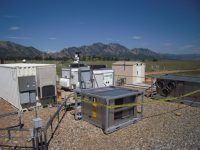Microgrids as Alternative to Centralized Power

In 2015 several municipalities in New York State were awarded $100,000 as part of Gov. Andrew Cuomo’s $40 Million NY Prize Microgrid Competition.
White Plains was one of them.
Phase II is now on the table, offering $8 million for local communities to develop engineering design and business plans for clean, resilient energy networks, which could operate independently during emergencies or power outages.
With the lessons of Super Storm Sandy and Hurricane Irene still in recent memory, the concept of tiny electric grids that can operate independently from the main grid and keep power flowing to hospitals, emergency shelters, government agencies and other facilities during blackouts is growing in popularity.
Phase II of the NY Prize was first announced by the Governor during his State of the State address in January 2016. “This competition will help make communities more resilient as well as bring New York one step closer in its goal toward achieving 50 percent renewable energy by 2030,” Cuomo said.
The NY Prize engineering design and business plan component will award up to $1 million to each of eight winners. The deadline for proposals is October 13, 2016.
Working to present a prize-winning plan for White Plains is Hitachi Microgrid Solutions, a relatively new company on the energy scene. Brian Levite, Senior Manager for the company spoke with The White Plains Examiner to explain how a plan for White Plains might work.
Hitachi has been working with the city’s Planning Department and has presented a feasibility study and proposal to the Mayor’s office for consideration. That proposal is currently under review.
Hitachi is also working with other municipalities in Westchester County and has completed a very successful cutting-edge microgrid project at Kashiwa-no-ha Smart City, Japan.
According to Levite, because White Plains has a small geographic footprint, it has the optimal structure for microgrid installations.
In Kashiwa-no-ha a smart grid shares solar, storage cell, and other distributed energy sources between districts. Peak electricity consumption for the entire town is cut by sharing electric power company and distributed power between districts through private transmission lines. As daytime office electricity consumption increases on weekdays, power is supplied to that area. On holidays, when shopping facility power demand increases, supplies are pushed in that direction. Peak power consumption by the city has been reduced by 26 percent, conserving energy and reducing carbon dioxide emissions.
Similarly, the White Plains proposal includes both government and private facilities including the White Plains Public Safety building, Westchester County government offices, White Plains Housing Authority, White Plains Public Library and White Plains Hospital. The Kensington senior living facility on Maple Avenue, the Galleria and potentially the new Boulevard multi-use project on the Post Road would be private groups joining the grid.
“The project is located within about three city blocks,” Levite said. Each participant would enter the grid agreement separately, but the value to residents and other businesses in the area would be felt in cases of emergency because they would provide public access for shelter and powering up of hand-held devices during outages.
On “regular” days because each facility has a different power profile, the grid would be able to push power in different directions at different times as needed.
Plus, White Plains could have more than one grid installation, according to Levite, who further explained that the plan does not currently allow for individual single-family residential hook-up.
Each grid, with current technology, would supply 2,300 kilowatts with natural gas and 1,900 kilowatts with photovoltaic (solar) energy.
The NY Prize competition is administered by the New York State Energy Research and Development Authority (NYSERDA), which is currently reviewing final reports and conducting an analysis and evaluation of the feasibility studies, which will be made public over the coming months.
Projects that are not chosen to receive engineering design and business plan funding will be connected to resources at NYSERDA, the New York Power Authority (NYPA), their local distribution utility and private sector companies to help them advance their clean energy agenda.
In related news, the Cuomo administration has also announced that New York State will participate in a federal auction to obtain a lease for offshore wind energy development in an area 11 miles off the Rockaways of Long Island.

